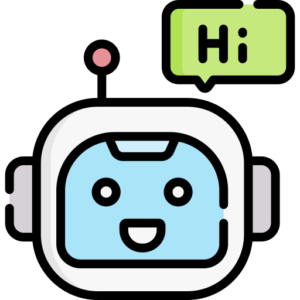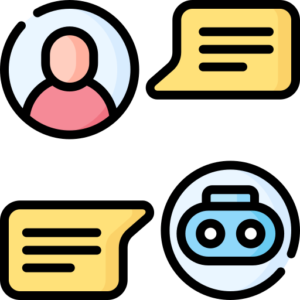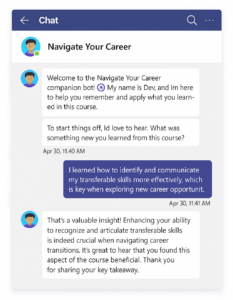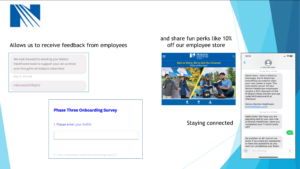What is a chatbot?
Chatbots are all around us. Even if you haven’t interacted with one directly, odds are good you’ve heard stories about well known chatbots like Alexa, Siri, or Google Assistant misinterpreting commands that leave users helpless and humored. But our chatbot usage goes much deeper than that, providing often unnoticed automated help and support.
Breaking the word down, “chat” and “robot” further explain the idea of a “chatbot.” A chatbot is a computer program (robot) capable of carrying an informal conversation (chat) with a person. Chatbots allow for engaging conversations to occur through voice and text.
- chat- an informal conversation.
- ro·bot – a machine capable of carrying out a complex series of actions automatically, especially one programmable by a computer.
- chat·bot – a computer program designed to simulate conversation with human users, especially over the Internet.
The idea of useful chatbots has been a prospect for many years now, so how close are we to seeing chatbots that simplify our lives? With chatbots becoming more and more prominent it’s likely that you have interacted with a chatbot today; and, if not today, almost certainly in the last week. But where? What do they look like? How do they work? What are they good for?
What does a chatbot look like and where do I use them?
 Modern chatbots come in many different forms and functions.
Modern chatbots come in many different forms and functions.
There are numerous chatbots on platforms like Facebook Messenger and sitting on many of your favorite e-commerce and SaaS sites. Text-based chatbots allow for one-on-one conversations between you and the bot. Commonly these conversations occur via SMS, Facebook Messenger, Slack, and in chat windows on websites. These text-based interactions can provide customer service for software, provide product recommendations, inform you of weather and news, or even conduct transactions for you, like ordering pizza.
Other chatbots of today include the well known personal assistant types—Siri, Alexa, and Google Assistant. These chatbots provide value by dialing calls for you, setting appointments, sending messages, and looking up information for you. Living in “smart” devices like your phone, speaker, TV, tablet and even your thermostat, these personal assistant chatbots are designed to make your life easier.
How do chatbots work?
Chatbots are developed to understand and communicate with users using a variety of automation technologies including Artificial Intelligence (AI), Natural Language Processing (NLP), or a Rules Engine.
Artificial Intelligence (AI) has been defined as “a system’s ability to correctly interpret external data, to learn from such data, and to use those learnings to achieve specific goals and tasks through flexible adaptation” by Kaplan and Haenlein. For many, AI is associated with learning and problem solving done by a computer.
Natural Language Processing (NLP) is technology that makes it possible for AI-powered computer programs to understand human language. Good examples of this are the virtual assistants that are found in cell phones and smart home gadgets.
A rules engine will break down text messages into individual components to interpret them according to predefined rules. A chatbot using a rules engine will then determine a suitable response, drawn from a Knowledge Base or continuing a prepared path of conversation.
All chatbots utilize these technologies in some form to execute the automation designed in the chatbot’s purpose and personality.
Why chatbots? What are they good for?
 Chatbots offer businesses a number of competitive advantages. These advantages can be separated into two broad categories: customer facing and employee facing.
Chatbots offer businesses a number of competitive advantages. These advantages can be separated into two broad categories: customer facing and employee facing.
Good examples of valuable customer facing chatbots are easy to find. One example is BB (BlueBot), the KLM Royal Dutch Airline chatbot on Facebook Messenger. BB’s main role is to assist the company’s team of humans working in live support. Each week they interact with over 16,000 customers, reported by MarTech Today. BB was designed to help keep KLM’s passengers up to date with flight information and even assist with booking tickets. Consequently, BB was able to engage with over half a million customers in its first six months, sending close to two million messages. Most people simply want correct, up-to-date information, no matter whether the answers are automated or personal. Chatbots like BB give consumers the information they need quickly and easily, all while being cost-effective for the businesses that deploy them.
Chatbots are an excellent resource for the front line of any customer service platform. They excel at providing help desk assistance such as providing answers to FAQ/database based inquiries.
Employee-facing chatbots offer numerous advantages for businesses. Chatbots are positioned perfectly to perform the function of employee training, like onboarding new employees. They can even carry out compliance training for topics such as safety, ethics, or diversity and inclusion. Chatbots also are excellent resources to provide access to an internal help desk, allowing employees to access the information they need at any time of day.
Conclusion
The technology behind chatbots is still emerging and growing more capable by the month. As technology continues to mature, chatbots will become a common presence in day-to-day interactions. In a world where users demand quick and easy access to information, chatbots are poised to allow industries to deliver cost-effective solutions.
Interested in learning more about chatbots? Click here for our entire blog series!
Want to learn more? Check out our second article, The History of Chatbots
Get a Demo
Learn how Mobile Coach chatbots will help you drive real engagement with your audience to achieve the key behaviors and results you want.



